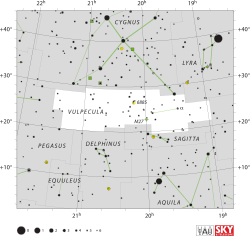17 Vulpeculae
| 17 Vulpeculae | |
 | |
| Observationsdata Epok: J2000.0 | |
|---|---|
| Stjärnbild | Räven |
| Rektascension | 20t 06m 53,40787s[1] |
| Deklination | +23° 36′ 51,9294″[1] |
| Skenbar magnitud () | +5,08 (V)[2], +5,056 ± 0,009 (V)[3] |
| Stjärntyp | |
| Spektraltyp | B3 V[4] |
| B–V | -0,162 ± 0,002[5] |
| Astrometri | |
| Radialhastighet () | -7,60 ± 0,8[6] km/s |
| Egenrörelse (µ) | RA: +15,59 ± 0,27[1] mas/år Dek.: +0,31 ± 0,14[1] mas/år |
| Parallax () | 6,47 ± 0,27[1] |
| Avstånd | 500 ± 20 lå (155 ± 6 pc) |
| Absolut magnitud () | -0,86[2] |
| Detaljer | |
| Massa | 6,1 ± 0,1[7] M☉ |
| Radie | 3,9[8] R☉ |
| Luminositet | 573,30[2] L☉ |
| Temperatur | 15 648[9] K |
| Metallicitet | -0,14 ± 0,04 (Fe/H)[2] dex |
| Vinkelhastighet | 115[10] km/s |
| Ålder | 10,7 ± 1,9[7] miljarder år |
| Andra beteckningar | |
| HR 7688[11], 2MASS J20065340+2336518[11], HD 190993[11], HIP 99080[11], SAO 88212[11], GSC 02154-04100[11], BD+23 3896[11], CEL 4933[11], EUVE J2006+23.5[11], FK5 3611[11], GC 27910[11], GCRV 12478[11], HIC 99080[11], N30 4447[11], PMC 90-93 1433[11], PPM 110432[11], ROT 2913[11], TD1 26062[11], TYC 2154-4100-1[11], UBV 17277[11], uvby98 100190993[11], YZ 23 7485[11], HGAM 837[11], WEB 17619[11], Gaia DR2 1833224949720791040[11], 17 Vul, Gaia DR3 1833224949722816768[11], TIC 393320918[11], AG+23 2009[11] och UBV M 24509[11][3][12] | |
17 Vulpeculae, som är stjärnans Flamsteed-beteckning, är en ensam stjärna[13] belägen i den södra delen av stjärnbilden Räven. Den har en lägsta skenbar magnitud på ca 5,08[2] och är svagt synlig för blotta ögat där ljusföroreningar ej förekommer. Baserat på parallaxmätning inom Hipparcosuppdraget på ca 6,5[1] mas, beräknas den befinna sig på ett avstånd på ca 500 ljusår (ca 155 parsek) från solen. Den rör sig närmare solen med en heliocentrisk radialhastighet av ca -8 km/s[6] och kommer att som närmast solen vara på ett avstånd av 419 ljusår om ca 6,1 miljoner år.[6]
Egenskaper[redigera | redigera wikitext]
17 Vulpeculae är en blå till vit stjärna i huvudserien av spektralklass B3 V.[4] Den har en massa som är ca 6,1[7] solmassor, en radie som är ca 3,9[8] solradier och utsänder ca 573[2] gånger mera energi än solen från dess fotosfär vid en effektiv temperatur på ca 15 600 K.[9] Stjärnan har snabb rotation med en projicerad rotationshastighet på 115 km/s.[10]
Referenser[redigera | redigera wikitext]
- Den här artikeln är helt eller delvis baserad på material från engelskspråkiga Wikipedia, 17 Vulpeculae, 11 september 2020.
Noter[redigera | redigera wikitext]
- ^ [a b c d e f] van Leeuwen, F. (2007), "Validation of the new Hipparcos reduction", Astronomy and Astrophysics, 474 (2): 653–664, arXiv:0708.1752, Bibcode:2007A&A...474..653V, doi:10.1051/0004-6361:20078357.
- ^ [a b c d e f] Anderson, E.; Francis, Ch. (2012), "XHIP: An extended hipparcos compilation", Astronomy Letters, 38 (5): 331, arXiv:1108.4971, Bibcode:2012AstL...38..331A, doi:10.1134/S1063773712050015.
- ^ [a b] ”Basic data: V* 17 Vul – Star” (på engelska). Centre de Données astronomiques de Strasbourg. http://simbad.u-strasbg.fr/simbad/sim-basic?Ident=17+Vul&submit=SIMBAD+search. Läst 7 juli 2019.
- ^ [a b] Lesh, Janet Rountree (December 1968), "The Kinematics of the Gould Belt: an Expanding Group?", Astrophysical Journal Supplement, 17: 371, Bibcode:1968ApJS...17..371L, doi:10.1086/190179.
- ^ van Leeuwen (2007). ”Hipparcos, the New Reduction” (på engelska). http://vizier.u-strasbg.fr/viz-bin/VizieR-5?-out.add=.&-source=I/311/hip2&HIP=99080. Läst 7 juli 2019.
- ^ [a b c] Gontcharov, G. A. (November 2006), "Pulkovo Compilation of Radial Velocities for 35 495 Hipparcos stars in a common system", Astronomy Letters, 32 (11): 759–771, arXiv:1606.08053, Bibcode:2006AstL...32..759G, doi:10.1134/S1063773706110065.
- ^ [a b c] Tetzlaff, N.; et al. (January 2011), "A catalogue of young runaway Hipparcos stars within 3 kpc from the Sun", Monthly Notices of the Royal Astronomical Society, 410 (1): 190–200, arXiv:1007.4883, Bibcode:2011MNRAS.410..190T, doi:10.1111/j.1365-2966.2010.17434.x.
- ^ [a b] Pasinetti Fracassini, L. E.; et al. (February 2001), "Catalogue of Apparent Diameters and Absolute Radii of Stars (CADARS)", Astronomy and Astrophysics (3rd ed.), 367 (2): 521–524, arXiv:astro-ph/0012289, Bibcode:2001A&A...367..521P, doi:10.1051/0004-6361:20000451.
- ^ [a b] McDonald, I.; Zijlstra, A. A.; Boyer, M. L. (2012), "Fundamental Parameters and Infrared Excesses of Hipparcos Stars", Monthly Notices of the Royal Astronomical Society, 427 (1): 343–57, arXiv:1208.2037, Bibcode:2012MNRAS.427..343M, doi:10.1111/j.1365-2966.2012.21873.x
- ^ [a b] Strom, Stephen E.; et al. (2005), "B Star Rotational Velocities in h and χ Persei: A Probe of Initial Conditions during the Star Formation Epoch?", The Astronomical Journal, 129 (2): 809–828, arXiv:astro-ph/0410337, Bibcode:2005AJ....129..809S, doi:10.1086/426748.
- ^ [a b c d e f g h i j k l m n o p q r s t u v w x y z aa ab ac] SIMBAD Astronomical Database.[källa från Wikidata]
- ^ "17 Vul". SIMBAD. Centre de données astronomiques de Strasbourg. Hämtad 2018-04-21.
- ^ Eggleton, P. P.; Tokovinin, A. A. (September 2008), "A catalogue of multiplicity among bright stellar systems", Monthly Notices of the Royal Astronomical Society, 389 (2): 869–879, arXiv:0806.2878, Bibcode:2008MNRAS.389..869E, doi:10.1111/j.1365-2966.2008.13596.x.





